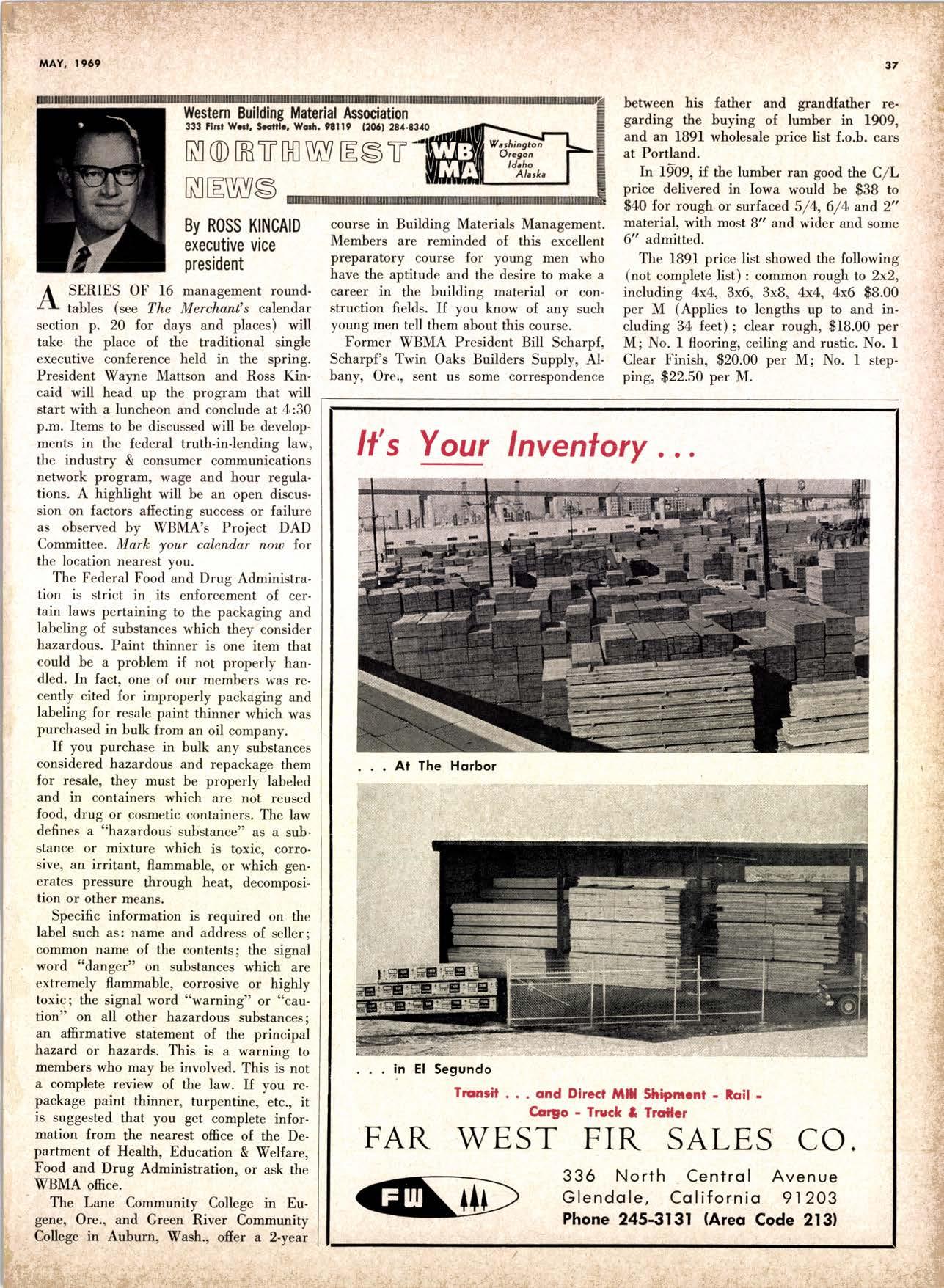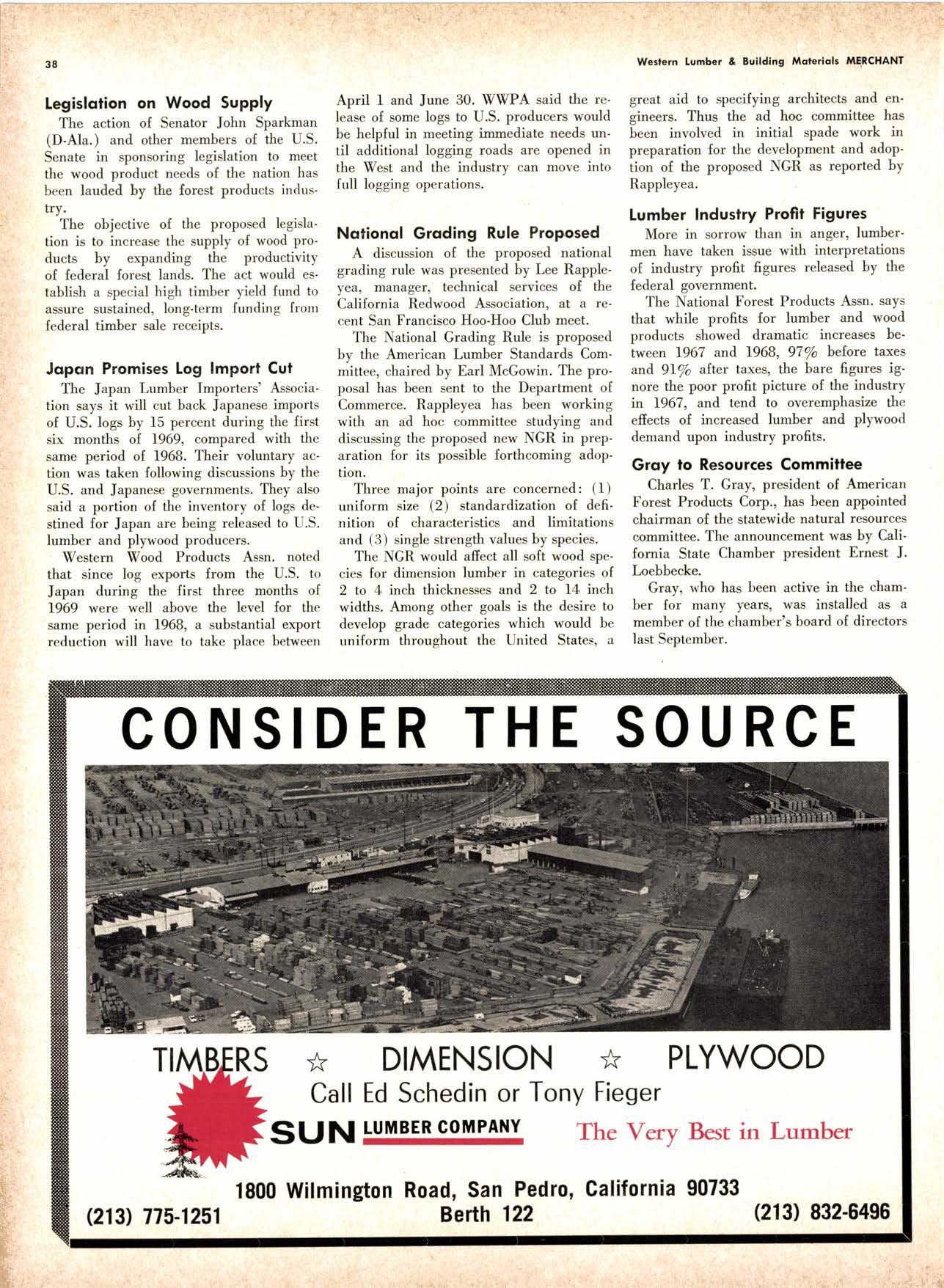
4 minute read
ilg#:'il'ff'EHf]ffi
By ROSS KINCAID executive vice president
A SERIES OF 16 management round- A tubl"r (see The Merchant's calendar section p. 20 for days and places) will take the place of the traditional single executive conference held in the spring. President Wayne Mattson and Ross Kincaid will head up the program t}at will start with a luncheon and conclude at 4:30 p.m. Items to be discussed will be developments in the federal truth-in-lending law, the industry & consumer communications network program, wage and hour regulations. A highlight will be an open discussion on factors affecting success or failure as observed by WBMA's Project DAD Committee. Mark your calend,ar now for the location nearest you.
The Federal Food and Drue Administration is strict in its enforcement oI certain laws pertaining to the packaging and labeling of substances which they consider hazardous. Paint thinner is one item that could be a problem if not properly handled. In fact. one of our members was recently cited for improperly packaging and labeling for resale paint thinner which was purchased in bulk from an oil company.
If you purchase in bulk any substances considered hazardous and repackage tlem for resale, they must be properly labeled and in containers which are not reused food, drug or cosmetic containers. The law defines a o'hazardous substance" as a substance or mixture which is toxic, corrosive, an irritant, flammable, or which generates pressure through heat, decomposition or other means.
Specific information is required on the label such as: name and address of seller; common name of the contents; the signal word ttdanger" on substances which are extremely flammable, corrosive or highly toxic; the sigrral word "warning" or o'caution" on all other hazardous substances; an afrrmative statement of the principal hazard or hazards. This is a warnins to members who may be involved. This is nor a complete review of the law. If you re. package paint thinner, turpentine, etc., it is suggested that you get complete information from the nearest office of the Department of Health, Education & Welfare, Food and Drug Administration, or ask the WBMA office.
The Lane Community College in Eugene, Ore., and Green River Community College in Auburn, Wash., ofier a 2.year course in Building Materials Management. Members are reminded of this excellent preparatory course {or young men who have the aptitude and the desire to make a career intle building material or construction fields. If you know of any such young men tell them about tlis course.
Former WBMA President Bill Scharpf, Scharpf's Twin Oaks Builders Supply, Albany, Ore., sent us some correspondence between his father and grandfather regarding the buying of lumber in 1909, and an 1891 wholesale price list f.o.b. cars at Portland.
In 1909, if the lumber ran good the C/L price delivered in Iowa would be $38 to $40 for rough or surfaced 5/4,6/4 and 2" material, with most 8" and wider and some 6" admitted.
The I89l price list showed the following (not complete list) : common rough to 2x2, including 4x4,3x6,3x8, 4x4, 4x6 $8.00 per M (Applies to lengths up to and including 34 feet); clear rough, $18.00 per M; No. I flooring, ceiling and rustic. No. I Clear Finish, $20.00 per M; No. I stepping, $22.50 per M.
Legislotion on Wood Supply
The action of Senator John Sparkman (D-Ala.) and other members of the U.S. Senate in sponsoring legislation to meet the wood product needs of the nation has been lauded by the lorest products indus' try.
The objective of the proposed legislation is to increase the supply of wood products by expanding the productivity of federal forest lands. The act would establish a special high timber yield fund to assure sustained, long-term funding from federal timber sale receipts.
Jopon Promises log lmport Cut
The Japan Lumber Importers' fusociation says it will cut back Japanese imports of U.S. logs by 15 percent during the first six months of 1969, compared with the same period of 1968. Their voluntary action was taken following discussions by the U.S. and Japanese governments. They also said a portion of the inventory of logs destined for Japan are being released to U.S. lumber and plywood producers.
'Western Wood Products Assn. noted that since log exports- from the U.S. to Japan during the first three months of 1969 were well above the level for the same period in 1968, a substantial export reduction will have to take place between
April I and June 30. WWPA said the reIease of some logs to U.S. producers would be helpful in meeting immediate needs until additional logging roads are opened in the West and the industry can move into full logging operations.
Notionol Groding Rule Proposed
A discussion of the proposed national grading rule was presented by Lee Rappleyea, manager, technical services o{ the California Redwood Association, at a recent San Francisco Hoo-Hoo Club meet.
The National Grading Rule is proposed by the American Lumber Standards Committee, chaired by Earl McGowin. The proposal has been sent to the Department of Commerce. Rappleyea has been working with an ad hoc committee studying and discussing the proposed new NGR in preparation for its possible forthcoming adoption.

Three major points are concerned: ( I ) uniform size (2) standardization of definition of characteristics and limitations and (3) single strengtl values by species.
The NGR would afiect all soft wood species for dimension lumber in categories of 2 to 4 inch thicknesses and 2 to 14 inch widths. Among other goals is the desire to develop grade categories which would be uniform throushout the United States, a great aid to specifying architects and en. gineers. Thus tJre ad hoc committee has been involved in initial spade work in preparation for the development and adoption of the proposed NGR as reported by Rappleyea,
lumber Industry Profit Figures
More in sorrow than in anger, lumber' men have taken issue with interpretations of industry profit figures released by the federal government.
The National Forest Products Assn. says that while profits for lumber and wood products showed dramatic increases between 1967 and 1968, 97/o belore taxes and 9l/o a{ter taxes, the bare figures ig' nore the poor profit picture of the industry in L967, and tend to overemphasize the efiects of increased lumber and plywood demand upon industry profits.
Groy to Resources Committee
Charles T. Gray, president of American Forest Products Corp., has been appointed chairman of the statewide natural resources committee. The announcement was by Cali' fornia State Chamber president Ernest J. Loebbecke.
Gray, who has been active in the chamber for many years, was installed as a member of the chamber's board oI directors last September.

![Ots[]ruAR[Es](https://assets.isu.pub/document-structure/230723114706-97e63af11a168e98adaa1f87acc1d925/v1/db2ef5d4896c1b2b058949bd592314fd.jpeg)






